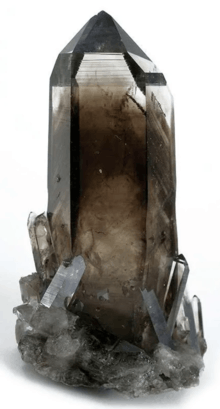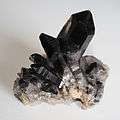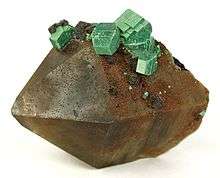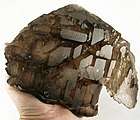Smoky quartz
Smoky quartz is a brownish grey, translucent variety of quartz that ranges in clarity from almost complete transparency to an almost-opaque brownish-gray or black crystal.[6] Like other quartz gems, it is a silicon dioxide crystal. The smoky colour results from free silicon formed from the silicon dioxide by natural irradiation.
| Smoky quartz | |
|---|---|
 | |
| General | |
| Category | Silicate minerals |
| Formula (repeating unit) | SiO2 |
| Strunz classification | 04.DA.05 |
| Dana classification | 75.01.03.01 |
| Crystal system | α-quartz: trigonal trapezohedral class 3 2; β-quartz: hexagonal 622[1] |
| Space group | Trigonal 32 |
| Unit cell | a = 4.9133 Å, c = 5.4053 Å; Z=3 |
| Identification | |
| Colour | Brown to grey, opaque |
| Crystal habit | 6-sided prism ending in 6-sided pyramid (typical), drusy, fine-grained to microcrystalline, massive |
| Twinning | Common Dauphine law, Brazil law and Japan law |
| Cleavage | {0110} Indistinct |
| Fracture | Conchoidal |
| Tenacity | Brittle |
| Mohs scale hardness | 7 – lower in impure varieties (defining mineral) |
| Lustre | Vitreous – waxy to dull when massive |
| Streak | White |
| Diaphaneity | Transparent to nearly opaque |
| Specific gravity | 2.65; variable 2.59–2.63 in impure varieties |
| Optical properties | Uniaxial (+) |
| Refractive index | nω = 1.543–1.545 nε = 1.552–1.554 |
| Birefringence | +0.009 (B-G interval) |
| Pleochroism | weak, from red-brown to green-brown |
| Melting point | 1670 °C (β tridymite) 1713 °C (β cristobalite)[1] |
| Solubility | Insoluble at STP; 1 ppmmass at 400 °C and 500 lb/in2 to 2600 ppmmass at 500 °C and 1500 lb/in2[1] |
| Other characteristics | lattice: hexagonal, Piezoelectric, may be triboluminescent, chiral (hence optically active if not racemic) |
| References | [2][3][4][5] |
Varieties
Morion is a very dark brown to black opaque variety. Morion is the German, Danish, Spanish and Polish synonym for smoky quartz.[7] The name is from a misreading of mormorion in Pliny the Elder.[8] It has a density of 5.4.
Cairngorm is a variety of smoky quartz found in the Cairngorm Mountains of Scotland. It usually has a smoky yellow-brown colour, though some specimens are greyish-brown. It is used in Scottish jewellery and as a decoration on kilt pins and the handles of sgianan-dubha (anglicised: sgian-dubhs or skean dhu). The largest known cairngorm crystal is a 23.6 kg (52 lb) specimen kept at Braemar Castle.
Uses
Smoky quartz is common and was not historically important, but in recent times it has become a popular gemstone, especially for jewellery.[9]
Sunglasses, in the form of flat panes of smoky quartz, were used in China in the 12th century.[10]
Gallery
 Morion variety
Morion variety Crystals of metazeunerite perched on a complete smoky quartz crystal
Crystals of metazeunerite perched on a complete smoky quartz crystal Smoky quartz found in a stream
Smoky quartz found in a stream_1.jpg) Smoky quartz, from Wushan Spessartine Mine, Fujian Province, China
Smoky quartz, from Wushan Spessartine Mine, Fujian Province, China A large specimen of sceptred smoky quartz from Nevada.
A large specimen of sceptred smoky quartz from Nevada. A two-sided cluster of glassy and lustrous, doubly terminated smoky quartz crystals from recent finds in Namaqualand, South Africa. The longest crystal is 8.1 cm.
A two-sided cluster of glassy and lustrous, doubly terminated smoky quartz crystals from recent finds in Namaqualand, South Africa. The longest crystal is 8.1 cm. This is an example of the so-called alligator quartz.
This is an example of the so-called alligator quartz. A 'large' specimen from a new find in Minas Gerais.
A 'large' specimen from a new find in Minas Gerais.
See also
References
- Deer, W. A., R. A. Howie and J. Zussman, An Introduction to the Rock Forming Minerals, Logman, 1966, pp. 340–355 ISBN 0-582-44210-9
- Anthony, John W.; Bideaux, Richard A.; Bladh, Kenneth W.; Nichols, Monte C. (eds.). "Quartz". Handbook of Mineralogy (PDF). III (Halides, Hydroxides, Oxides). Chantilly, VA, US: Mineralogical Society of America. ISBN 0962209724.
- Quartz. Mindat.org. Retrieved on 2013-03-07.
- Quartz. Webmineral.com. Retrieved on 2013-03-07.
- Hurlbut, Cornelius S.; Klein, Cornelis (1985). Manual of Mineralogy (20 ed.). ISBN 0-471-80580-7.
- "Smoky Quartz: Smoky Quartz mineral information and data".
- http://www.mindat.org/min-6270.html Morion on Mindat
- New Oxford American Dictionary (2nd ed., 2005), p. 1102.
- "The Gemstone Smoky Quartz". minerals.net. Retrieved 14 December 2015.
- Joseph Needham, Science & Civilisation in China (Cambridge, England: Cambridge University Press, 1962), volume IV, part 1, page 121. Needham states that dark glasses were worn by Chinese judges to hide their facial expressions during court proceedings.
| Wikisource has original text related to this article: |
- Holden, Edward (1925). "The Cause of Color in Smoky Quartz and Amethyst" in American Mineralologist, vol. 9, pp. 203–252